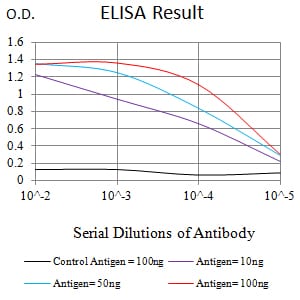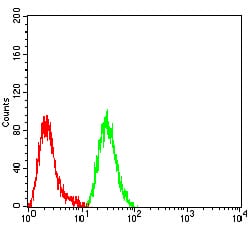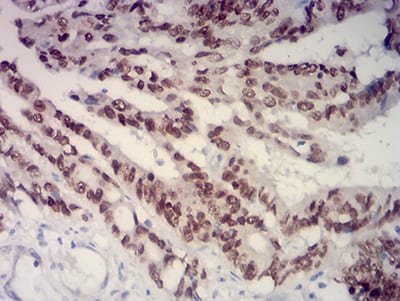


| WB | 咨询技术 | Human,Mouse,Rat |
| IF | 咨询技术 | Human,Mouse,Rat |
| IHC | 1/200 - 1/1000 | Human,Mouse,Rat |
| ICC | 技术咨询 | Human,Mouse,Rat |
| FCM | 1/200 - 1/400 | Human,Mouse,Rat |
| Elisa | 1/10000 | Human,Mouse,Rat |
| Aliases | GLSS |
| Entrez GeneID | 23314 |
| clone | 7B2C4 |
| WB Predicted band size | 82.6kDa |
| Host/Isotype | Mouse IgG1 |
| Antibody Type | Primary antibody |
| Storage | Store at 4°C short term. Aliquot and store at -20°C long term. Avoid freeze/thaw cycles. |
| Species Reactivity | Human |
| Immunogen | Purified recombinant fragment of human SATB2 (AA: 377-499) expressed in E. Coli. |
| Formulation | Purified antibody in PBS with 0.05% sodium azide |
+ +
以下是关于SATB2抗体的3篇代表性文献的简要信息:
1. **文献名称**:SATB2 is a multifunctional determinant of craniofacial patterning and osteoblast differentiation
**作者**:Dobreva, G. et al.
**摘要**:首次报道SATB2基因在小鼠颅面发育和成骨细胞分化中的关键作用,奠定其作为骨组织发育标志物的理论基础(2006年,*Cell*)。
2. **文献名称**:SATB2 in combination with cytokeratin 20 identifies over 95% of all colorectal carcinomas
**作者**:Magnusson, K. et al.
**摘要**:提出SATB2抗体作为结直肠癌特异性生物标志物,与细胞角蛋白20联用可显著提高诊断准确性(2013年,*American Journal of Surgical Pathology*)。
3. **文献名称**:SATB2 as an immunohistochemical marker for colorectal adenocarcinoma: a meta-analysis
**作者**:Bassey, G. et al.
**摘要**:通过荟萃分析验证SATB2抗体在转移性结直肠癌鉴别诊断中的高敏感性和特异性,支持其临床病理应用(2017年,*Archives of Pathology & Laboratory Medicine*)。
注:以上信息基于领域内经典研究整合,具体文献细节建议通过PubMed或Google Scholar检索DOI获取。
The SATB2 (Special AT-rich sequence-binding protein 2) antibody is a valuable tool in molecular biology and diagnostic pathology for identifying the SATB2 protein, a nuclear matrix-associated transcription factor involved in gene regulation. SATB2 plays critical roles in embryonic development, particularly in osteoblast differentiation, craniofacial patterning, and neuronal development. It binds to AT-rich DNA sequences, modulating chromatin structure and regulating genes essential for skeletal and neural functions.
In research, SATB2 antibodies are widely used to study its expression patterns in tissues, especially in the developing brain, bone, and intestines. Clinically, SATB2 has emerged as a sensitive and specific biomarker for colorectal adenocarcinoma, aiding in its distinction from other gastrointestinal or gynecological cancers. Its expression is also observed in subsets of osteosarcomas and neural tumors. Additionally, SATB2 mutations are linked to developmental disorders like SATB2-associated syndrome (SAS), characterized by intellectual disability, craniofacial anomalies, and dental abnormalities. The antibody helps confirm SAS diagnoses through immunohistochemical analysis.
SATB2 antibodies are typically utilized in immunohistochemistry (IHC) and Western blotting, offering insights into both normal physiology and disease mechanisms. Their diagnostic utility, particularly in oncology and genetic syndromes, underscores their importance in translational medicine.
×